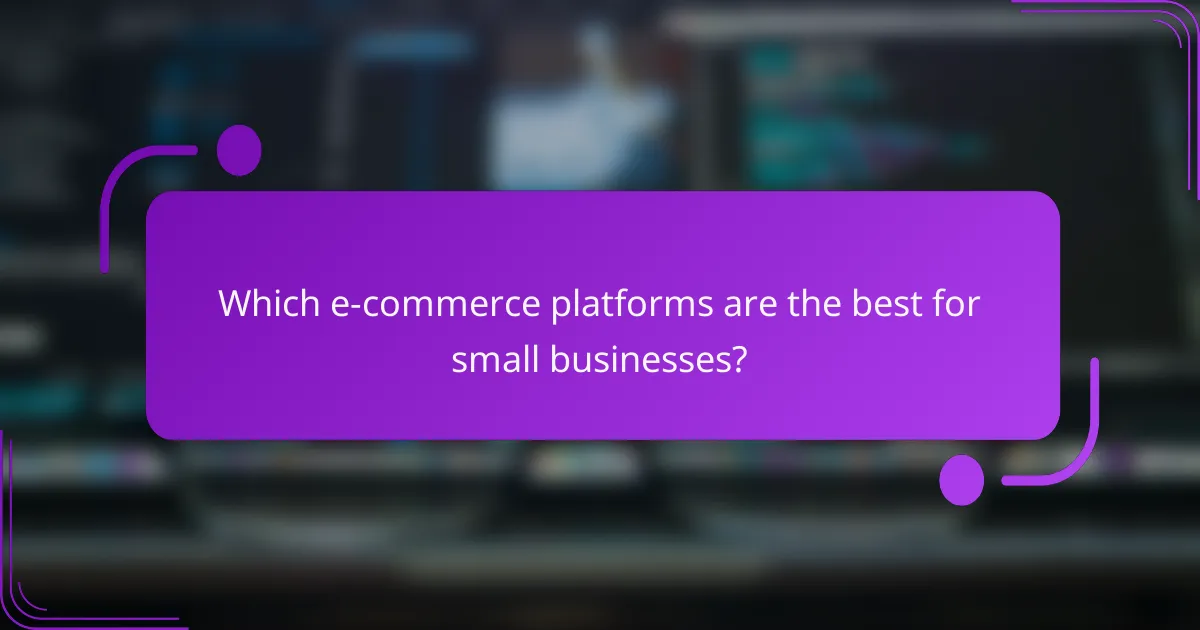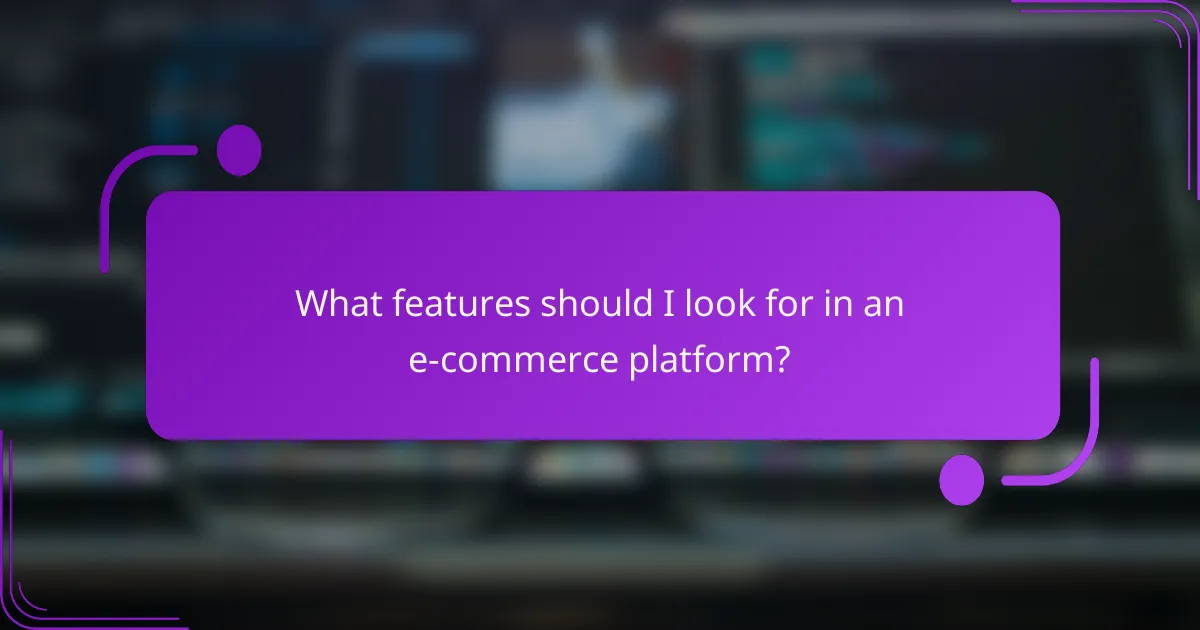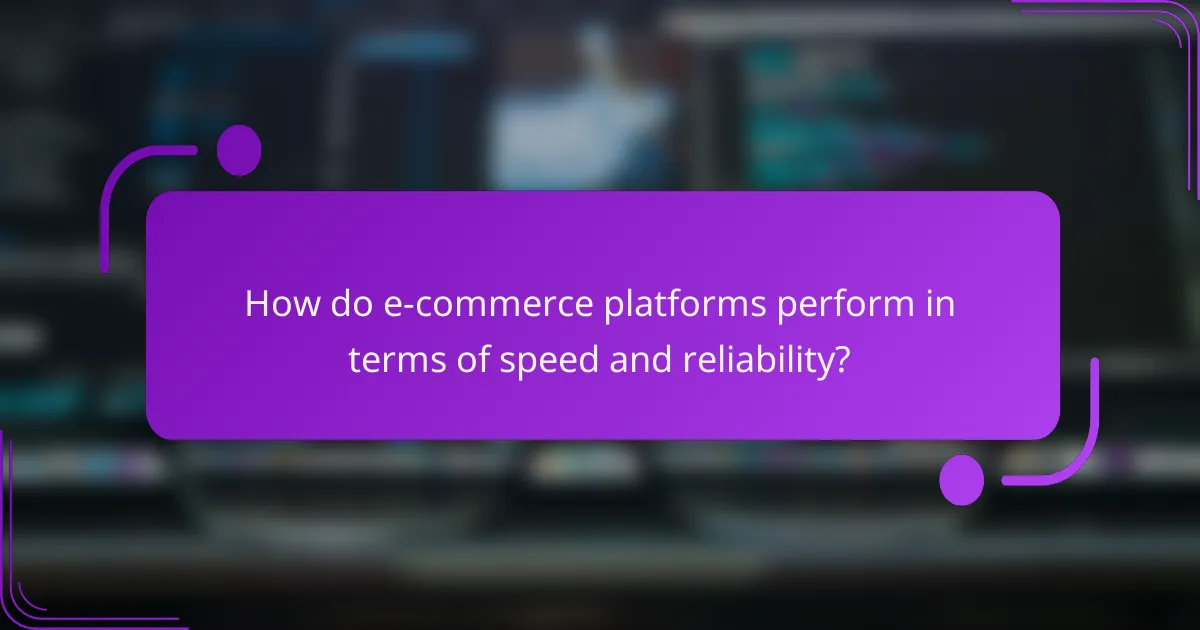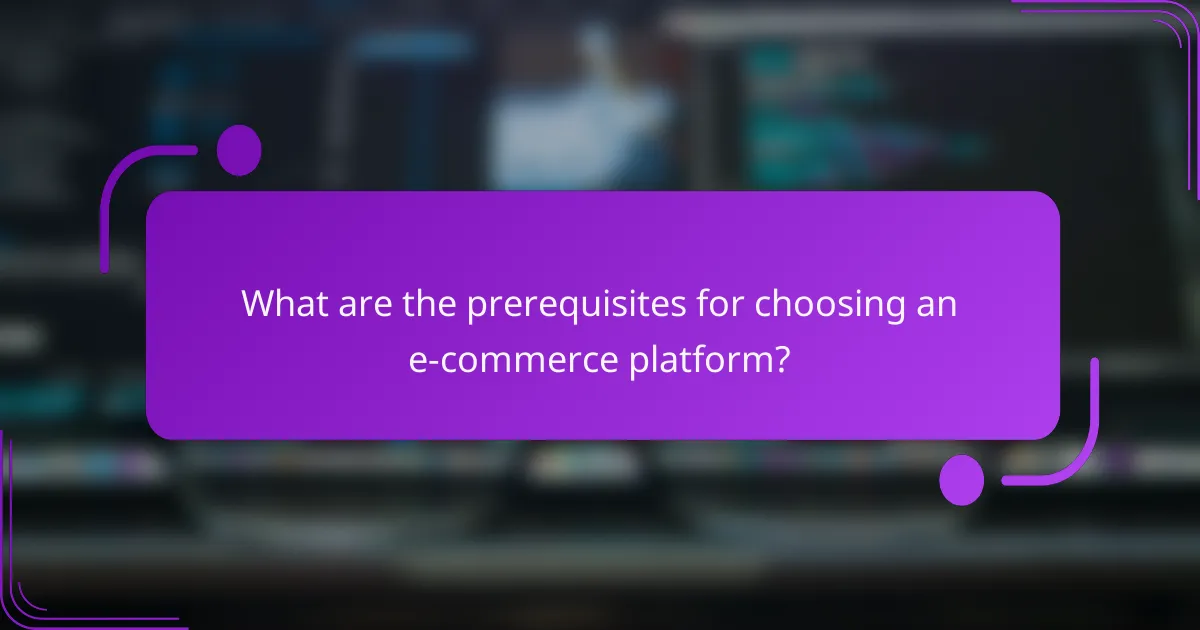E-commerce platforms are essential for small businesses seeking to establish an online presence, offering a range of user-friendly and scalable solutions. With options like Shopify, WooCommerce, and BigCommerce, businesses can choose a platform that aligns with their budget and specific needs. Costs can vary significantly based on the features and services included, making it crucial to evaluate which functionalities will best support growth and enhance user experience.

Which e-commerce platforms are the best for small businesses?
Small businesses often benefit from e-commerce platforms that are user-friendly, affordable, and scalable. The best options typically include Shopify, WooCommerce, BigCommerce, Squarespace, and Magento, each catering to different needs and budgets.
Shopify features and pricing
Shopify is a leading e-commerce platform known for its ease of use and robust features. Pricing starts around $29 per month, offering essential tools like customizable templates, payment processing, and inventory management.
Shopify’s app store provides additional functionalities, allowing users to enhance their stores with marketing tools, shipping solutions, and customer service integrations. It’s ideal for small businesses looking to quickly set up an online store without extensive technical knowledge.
WooCommerce benefits for WordPress users
WooCommerce is a powerful plugin for WordPress, making it a great choice for those already using the platform. It is free to install, but users may incur costs for hosting, themes, and additional plugins, which can range from a few dollars to several hundred, depending on the features needed.
This platform offers extensive customization options, allowing businesses to tailor their online stores to their specific needs. However, users should be comfortable with WordPress to maximize WooCommerce’s potential.
BigCommerce scalability options
BigCommerce is designed for growth, making it suitable for small businesses planning to scale. Its pricing starts at approximately $29.95 per month, with features that support larger catalogs and higher sales volumes without significant performance drops.
BigCommerce includes built-in SEO tools and multi-channel selling capabilities, which can help businesses reach a broader audience. It’s a solid choice for those anticipating rapid growth and needing a platform that can keep pace.
Squarespace e-commerce capabilities
Squarespace offers visually appealing templates and is ideal for small businesses focused on design. Pricing for e-commerce features starts around $18 per month, which includes tools for selling products, managing inventory, and processing payments.
While Squarespace is user-friendly, it may lack some advanced e-commerce functionalities compared to other platforms. It’s best suited for businesses that prioritize aesthetics and straightforward online selling.
Magento flexibility for larger stores
Magento is a highly flexible platform that caters to larger small businesses or those with complex needs. While the open-source version is free, hosting and development costs can add up significantly, often reaching thousands of dollars annually.
Magento allows for extensive customization and scalability, making it suitable for businesses with unique requirements or large inventories. However, it requires more technical expertise to manage effectively, so businesses should consider their resources before choosing this option.

How much do e-commerce platforms cost?
E-commerce platform costs vary widely based on features, scalability, and service levels. Basic plans can start from low monthly fees, while advanced options with extensive features may reach hundreds of dollars each month.
Shopify pricing tiers
Shopify offers several pricing tiers, starting from around $39 per month for the Basic plan, which includes essential features for small businesses. The Shopify plan, priced at approximately $105 monthly, adds more advanced reporting and gift card capabilities, while the Advanced plan, at about $399, provides even deeper analytics and lower transaction fees.
Consider your business size and growth potential when choosing a tier. Starting with a basic plan is often advisable, allowing you to upgrade as your needs evolve.
WooCommerce setup costs
WooCommerce is a free plugin for WordPress, but setup costs can accumulate. You may need to budget for hosting, which typically ranges from $5 to $30 per month, and additional expenses for premium themes and plugins, which can vary widely.
Keep in mind that while WooCommerce has no monthly fees, costs can add up based on the features you choose to implement. It’s essential to assess your specific requirements to avoid unexpected expenses.
BigCommerce monthly fees
BigCommerce offers several plans, starting at around $39 per month for the Standard plan, which includes essential features for growing businesses. The Plus plan, priced at approximately $105 monthly, adds features like customer segmentation and abandoned cart recovery.
Evaluate the features included in each plan to ensure they align with your business needs. Upgrading to higher tiers can provide additional tools for scaling your operations effectively.
Squarespace subscription plans
Squarespace offers e-commerce capabilities through its subscription plans, starting at about $18 per month for the Personal plan, which is suitable for small online stores. The Business plan, around $26 monthly, includes additional features like promotional pop-ups and advanced analytics.
When selecting a Squarespace plan, consider the level of customization and e-commerce features you require. The higher-tier plans offer more robust tools for managing an online store effectively.

What features should I look for in an e-commerce platform?
When selecting an e-commerce platform, focus on features that enhance user experience, streamline operations, and support growth. Key aspects include payment gateway integrations, mobile responsiveness, SEO tools, and inventory management systems.
Payment gateway integrations
Payment gateway integrations are crucial for facilitating secure transactions on your e-commerce site. Look for platforms that support multiple payment options, including credit cards, digital wallets, and local payment methods, which can vary by region.
Ensure the platform complies with PCI DSS standards to protect customer data. Popular gateways like PayPal, Stripe, and Square offer robust solutions, but consider transaction fees and processing times when making your choice.
Mobile responsiveness
Mobile responsiveness ensures that your e-commerce site functions well on smartphones and tablets. With a significant portion of online shopping occurring on mobile devices, a responsive design can greatly enhance user experience and conversion rates.
Choose a platform that automatically adjusts layouts and elements based on screen size. Test the mobile version of your site regularly to ensure it loads quickly and is easy to navigate, as slow loading times can lead to cart abandonment.
SEO tools and capabilities
SEO tools are essential for improving your site’s visibility in search engine results. Look for platforms that offer built-in SEO features like customizable URLs, meta tags, and alt text for images.
Additionally, consider platforms that provide analytics to track your SEO performance. This data can help you refine your strategies and improve your rankings over time, driving more organic traffic to your store.
Inventory management systems
An effective inventory management system helps you track stock levels, manage orders, and forecast demand. Choose a platform that integrates seamlessly with your inventory system to minimize errors and streamline operations.
Look for features like real-time inventory updates, low-stock alerts, and reporting tools. These capabilities can help you avoid stockouts and overstock situations, ultimately improving customer satisfaction and profitability.

How do e-commerce platforms perform in terms of speed and reliability?
E-commerce platforms are evaluated based on their speed and reliability, which are crucial for user experience and conversion rates. High performance typically means faster load times, minimal downtime, and consistent availability, all of which contribute to customer satisfaction and retention.
Shopify uptime statistics
Shopify boasts an impressive uptime record, often exceeding 99.9%. This reliability ensures that online stores remain accessible to customers, which is vital for maintaining sales and trust. Regular monitoring and maintenance help Shopify achieve these high standards.
In practice, this means that Shopify stores may experience only a few hours of downtime annually, which is significantly lower than the industry average. Users can rely on Shopify’s infrastructure to handle traffic spikes, especially during peak shopping seasons.
BigCommerce performance metrics
BigCommerce also offers strong performance metrics, with uptime rates typically around 99.9%. This platform is designed to support high-volume sales, making it suitable for larger businesses. Its architecture allows for quick page loads, which can be crucial for retaining customers.
On average, BigCommerce sites load within a few hundred milliseconds, which is competitive in the e-commerce space. Users should regularly test their site speed and optimize images and scripts to maintain these performance levels.
WooCommerce speed optimization tips
WooCommerce performance can vary significantly based on hosting and configuration. To enhance speed, users should choose a reliable hosting provider and consider using a Content Delivery Network (CDN) to distribute content efficiently. This can significantly reduce load times for customers across different regions.
Additionally, optimizing images, minimizing plugins, and utilizing caching solutions can improve site performance. Regularly updating the platform and its components is also essential to ensure security and speed. Users should monitor their site’s performance with tools like Google PageSpeed Insights to identify areas for improvement.

What are the prerequisites for choosing an e-commerce platform?
Choosing an e-commerce platform requires careful consideration of various factors, including your business size, technical expertise, and budget. Understanding these prerequisites will help you select a platform that aligns with your operational needs and growth objectives.
Business size and scale considerations
Your business size significantly influences the choice of an e-commerce platform. Small businesses may benefit from user-friendly platforms with lower costs, while larger enterprises might need more robust solutions that support extensive product catalogs and high traffic volumes.
Consider the scalability of the platform. Look for options that can grow with your business, allowing for increased product listings and customer traffic without compromising performance. Platforms that offer tiered pricing or features can be advantageous as your business expands.
Technical expertise requirements
The level of technical expertise within your team is crucial when selecting an e-commerce platform. If your team lacks technical skills, opting for a platform with a simple interface and minimal coding requirements is advisable. Platforms like Shopify or Wix are designed for ease of use.
For businesses with technical resources, more complex platforms like Magento or WooCommerce may offer greater customization and functionality. However, ensure you have the necessary skills to manage and maintain these systems effectively.
Budget constraints
Your budget will play a vital role in determining which e-commerce platform to choose. Platforms vary widely in cost, from free open-source options to subscription-based services that can range from a few dozen to several hundred dollars per month.
When evaluating costs, consider not only the subscription fees but also additional expenses such as payment processing, hosting, and any necessary plugins or extensions. Create a budget that accounts for both initial setup and ongoing operational costs to avoid unexpected financial strain.
